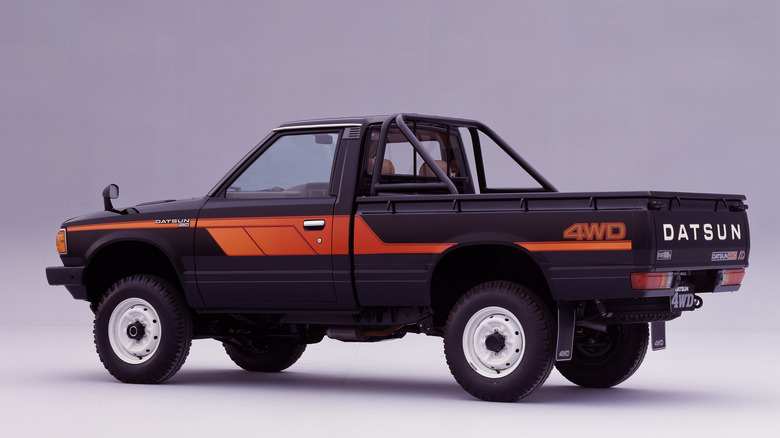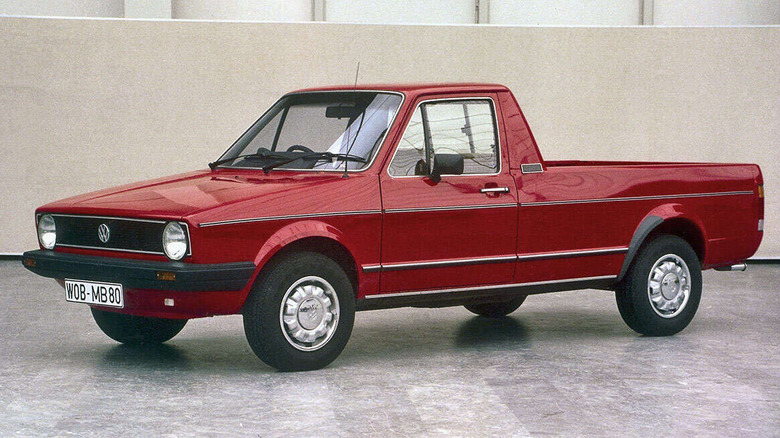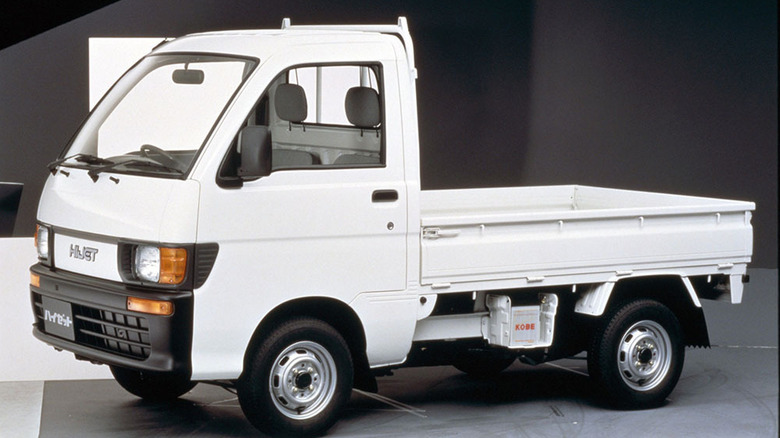A Small Single-Cab Pickup Could Dominate The Market, So Where Are They?
There's a popular sentiment on the internet that a small, affordable pickup truck would theoretically make the perfect work truck, especially in cities and towns without massive projects demanding large payloads. Something light, comfortable enough to drive all day, durable enough to last well beyond 15 or 20 years with proper maintenance, and with only the bare necessities to help keep costs down and efficiency high. After all, this is a work truck, not a status symbol.
This niche used to be filled by a wide and diverse array of manufacturers, foreign and domestic, with trucks like the Ford Courier (or Mazda B-Series), Chevrolet S-10, Isuzu Faster, Datsun Truck, Dodge Ram 50, and dozens more. These trucks were all the rage in the 1980s — compact, dead-simple, honest work trucks. So where did they all go?
I'm someone with a great love and fondness for these sorts of vehicles, not just because of their unique quirks, but because of their single-minded functionality. Let's be real, though: these trucks aren't just great for small business owners and construction workers. They're quirky, fun, and just plain cool, plus they make great starter projects. As someone with a long-standing passion for classic, basic cars, I would love to see these return. But could they ever actually make a comeback? Why did they fade into obscurity in the first place? And are we actually just looking through rose-tinted glasses? Here, I'll examine all the angles, looking at the hard data and speculating whether such vehicles could see a viable return — if they haven't secretly returned already. Let's dive right in.
What is a small pickup truck?
First things first: I need to establish exactly what "small pickup truck" means in this context. The short answer is that a small pickup truck is anything more compact than the smallest traditionally-built truck in a manufacturer's lineup; usually two-door, with a useful pickup bed for its size. For example, the Chevrolet S-10, which debuted in 1981, was as small as a midsize family car, contrasting the full-size C/K series. Similarly, trucks like the Jeep CJ-8 "Scrambler" and Comanche contrasted with the company's J-series trucks. Then there's the Dodge Dakota versus Ram and Ramcharger, the Ford Courier and Ranger versus the F-series, and so on.
Small trucks also encompass anything based on a car chassis that is clearly a car, so something like an Australian ute, for example. These were around in U.S. markets since the 1950s, with vehicles like the Chevrolet El Camino and Ford Ranchero. While those are the most prominent examples, other manufacturers experimented with their own versions, like the Pontiac "El Catalina" prototype. These proved especially popular in places like Europe and Asia, with vehicles such as the Citroën 2CV, Mini, and Volkswagen Caddy, among others, seeing popularity for decades. These trucks effectively combined the comfort, size, and feel of a car with the utility of a truck, making them perfect for light-duty work.
Finally, we arrive at Japanese kei trucks, which are the smallest trucks available for popular sale today. Kei trucks have a history spanning over 70 years and counting, and follow strict government regulations for maximum dimensions and engine size. They can be no longer than 3.4 meters (about 11 feet and 2 inches) and have an engine no larger than 660cc, or 40.2 CI.
Why the small pickup truck exists
Why did small trucks exist when trucks like the Ford F-series had been around since 1948? Back then, many trucks derived body styles from military variants, like the Dodge Power Wagon, and were largely considered agricultural tools. But as someone who's seen more than my fair share of Power Wagons, I'd never accuse these of being compact trucks — quite the opposite. These lumbering body-on-frame titans were overbuilt workhorses, designed to haul goods cross-country. But what if you didn't need that much metal and instead wanted something basic, efficient, and cheap, a runabout-town truck good for light-duty jobs? That's where the compact pickup came in.
Arguably, the first dedicated postwar compact pickup truck debuted in the U.S. in 1958. The Datsun Truck was one of Japan's first stateside exports, predating the Subaru 360's failed U.S. debut by a decade. These trucks were effectively the first true utes — a car with a truck bed — marketed in the United States, and people loved them. The market exploded, with trucks like the Mazda B-Series and sister Ford Courier, the Mini Cooper pickup, the Suzuki Carry and its many derivatives, and more arriving throughout the 1960s and 1970s. Japan proved especially fertile ground, with kei trucks and cars providing the means for rapid development after World War II, fueling the Japanese economic miracle.
These trucks were perfect for small businesses, private owners, basic transporters, and more. They weren't luxurious and generally only had single cabs, but they provided the backbone for rapid agricultural development and light-duty work around the world. These also quickly became "cool" in their own right as more advanced, sportier models debuted.
Where did they go?
This is basically the Fermi Paradox of the automotive world: if these vehicles were so popular and durable, why do you never see them anymore on U.S. roads? That's a complicated answer, so I'll explain it chronologically. Firstly, the "Chicken Tax" was introduced in 1964, which placed a 25% tariff on imported trucks. Manufacturers found ways around this, however, like the Ford Courier being a badge-engineered Mazda.
Next was the 1973 Oil Crisis, which brought with it the 1975 Corporate Average Fuel Economy (CAFE) Standards. This is what governed vehicles to have certain emissions restrictions, but it was particularly lax concerning trucks — the larger the truck, the easier it was to pass emissions standards, a policy remaining in place until June 2025.
Then came the cultural shift to larger trucks in general. This isn't strictly political, nor economic. Instead, it was a gradual shift that took place over decades: Inflation and interest rates began rapidly climbing, customer sensibilities shifted, and manufacturers began prioritizing and marketing more luxurious options. Effectively, at least within U.S. markets, trucks became status symbols by the 2000s thanks to their premium features and technology, eventually becoming synonymous with masculinity and a work-centric mindset. Concurrently, there was the "luxury truck" movement, with vehicles like the Lincoln Blackwood, Cadillac Escalade EXT, and others debuting during this timeframe as well.
Lastly, there was one of the worst car trends ever: the Car Allowance Rebate System (CARS), or "Cash for Clunkers," a rebate program in 2009 designed to re-incentivize automotive production by changing over to newer, more fuel-efficient models. The vast majority of the trade-ins were old pickup trucks, slashing significant numbers of survivors and spurring the development of new, lucrative options for owners looking to capitalize on trade-in values.
Could they feasibly come back?
Could a manufacturer build a small pickup truck again? Sure — I'd love that, myself. But will it happen? Probably not. To see why, let's look at the hard numbers behind some of these vehicles. The Jeep Comanche never sold particularly well, reaching about 200,000 units before its discontinuation. The Chevrolet S-10, a vastly more popular truck, sold as many units as the Comanche in a single year. However, by the mid-2000s, its annual production numbers dwindled to low-five-figure sales at best, and three figures at worst.
This trend continues into the present day with the modern Ford Ranger. While it's hardly a "small" pickup truck by my definition, it's still smaller than an F-series. Yet the F-series comfortably outsells it by a ratio of about 10 to one annually. Basically, people need to demonstrate a willingness to buy them for manufacturers to start building them again, and the numbers haven't been there in decades.
This trend applies to compact vehicles in general. The crossover era is in full swing, with some manufacturers, such as Buick, no longer offering passenger cars at all. The USDM variants of cars like the Toyota Yaris and Honda Fit were discontinued due to poor sales, and the Big Three's pickup trucks all remain comfortably at the higher end of the sales charts, followed by crossovers — even the mighty Toyota Camry places at number seven in the highest-selling vehicles in 2025 so far. So, while many people on forums and videos cry out for the small pickup to return, it's ultimately a niche endeavor, at least as far as the wider market is concerned.
Are they secretly among us?
Small pickups do exist on American roads, though, and in a big way. When I was shopping around for my first JDM import, I found pages upon pages of cheap, low-mileage kei trucks and compact pickups. I see kei trucks all the time in New York City, where they fit into any spot, and ride high enough that you're not breaking your back trying to lift boxes in and out of the thing. Kei trucks also carry a surprising amount of cargo, hence why they're gaining popularity stateside.
The same applies to the used pickup truck market, with used compact pickup sales projected to increase exponentially over time. There's a certain nostalgia factor at play, certainly, but there's also the fact that the cheapest modern pickups still cost around $30,000, a tough pill to swallow when you consider that an older, functional work truck from the early-2000s does exactly the same job and for way cheaper. And when it wears out, you can just buy another one for cheap and keep working. My delivery job in college pulled this act for decades, with many vehicles in the fleet being single-cab small trucks that were perfect for hauling car parts from warehouse to warehouse.
This resurgence isn't going unnoticed by auto manufacturers, either. The most recent and prominent example of this is Toyota's $13,000 mini truck concept, the IMV 0. It's effectively a frame with some panels and a single-cab arrangement, and it's being lauded as the harbinger of a new generation of work trucks. Considering its price, the IMV 0 will make it far easier to put our money where our mouths are. Time will tell.





